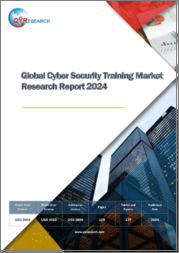
|
시장보고서
상품코드
1781593
세계의 사이버 보안 트레이닝 시장 : 산업 분석, 규모, 점유율, 성장률, 동향, 예측(2025-2033년)Global Cyber Security Training Market Research Report- Industry Analysis, Size, Share, Growth, Trends and Forecast 2025 to 2033 |
||||||
세계의 사이버 보안 트레이닝 시장 규모는 2024년 62억 9,000만 달러에서 2033년에는 279억 8,000만 달러로 성장하며, 2026-2033년의 예측 기간 중 18.03%의 견고한 연평균 성장률(CAGR)을 보일 것으로 예측됩니다.
사이버 보안 교육 시장은 다양한 분야의 조직이 직면한 사이버 위협의 빈도와 교묘함 증가로 인해 빠르게 성장하고 있습니다. 기업이 디지털 자산 보호의 중요성을 인식함에 따라 종합적인 사이버 보안 교육 프로그램에 대한 수요가 급증하고 있습니다. 이러한 프로그램은 직원들이 잠재적 위협을 식별하고 완화하는 데 필요한 지식과 기술을 습득하고 조직내 보안 인식 문화를 조성하는 데 도움이 됩니다. 원격 근무와 디지털 전환 개념의 부상으로 직원들이 복잡해지는 환경 속에서 새로운 보안 과제를 해결하기 위해 효과적인 교육 솔루션의 필요성이 더욱 커지고 있습니다.
또한 진화하는 규제 상황이 사이버 보안 교육 시장을 형성하고 있습니다. 정부 및 규제기관은 더욱 엄격한 규정 준수 요건을 도입하고 있으며, 기업은 업계 표준을 충족하는 교육 프로그램에 투자해야 합니다. 이러한 컴플라이언스에 대한 강조는 시장 개발을 위한 혁신의 원동력이 되고 있으며, 교육 프로바이더들은 특정 규제 요건과 업계 베스트 프랙티스에 대응하는 맞춤형 솔루션을 개발하고 있습니다. 조직이 컴플라이언스 및 리스크 관리를 우선시함에 따라 사이버 보안 교육에 대한 수요가 증가하고, 교육 프로바이더가 제공하는 서비스를 확대할 수 있는 기회가 창출될 것으로 예측됩니다.
또한 지속적인 학습과 전문성 개발을 중시하는 경향이 강화되고 있는 것도 사이버 보안 교육 시장에 영향을 미치고 있습니다. 사이버 위협 상황이 진화함에 따라 조직은 직원들에게 최신 위협 및 보안 관행에 대한 정보를 제공하기 위해 지속적인 교육이 필요하다는 것을 인식하고 있습니다. 이러한 추세는 온라인 코스, 워크샵, 시뮬레이션 등 다양한 학습 선호도를 충족시키는 유연하고 사용하기 쉬운 교육 솔루션의 개발을 촉진하고 있습니다. 사이버 보안 교육 시장의 미래는 지속적인 혁신, 컴플라이언스에 대한 헌신, 그리고 조직이 탄력적인 보안 문화를 구축할 수 있도록 하는 데 중점을 두는 것이 특징이 될 것입니다.
우리의 보고서는 고객에게 다양한 산업과 시장에 대한 종합적이고 실용적인 인사이트를 제공하기 위해 세심하게 작성되었습니다. 각 보고서에는 시장 상황을 완전히 이해하기 위한 몇 가지 중요한 요소가 포함되어 있습니다.
시장 개요: 정의, 분류, 산업 현황 등 시장에 대한 자세한 정보.
시장 역학: 시장 성장에 영향을 미치는 주요 촉진요인, 억제요인, 기회 및 과제를 상세하게 분석합니다. 이 섹션에서는 기술 발전, 규제 변화, 새로운 동향 등의 요인을 살펴봅니다.
세분화 분석 : 유형, 제공 방식, 컨텐츠, 지역 등의 기준에 따라 시장을 명확한 부문으로 세분화합니다. 이 분석을 통해 각 부문의 실적과 미래성을 파악할 수 있습니다.
경쟁 구도: 시장 점유율, 제품 포트폴리오, 전략적 구상, 재무 실적 등 주요 시장 기업에 대한 종합적인 평가를 수행합니다. 주요 기업이 채택하고 있는 경쟁 역학 및 주요 전략에 대한 인사이트을 제공합니다.
시장 예측 : 과거 데이터와 현재 시장 상황을 바탕으로 일정 기간 시장 규모와 성장 추세를 예측합니다. 여기에는 정량적 분석과 미래 시장 궤적을 보여주는 그래프 표시가 포함됩니다.
지역별 분석 : 지역별 시장 성과를 평가하고 주요 시장 및 지역 동향을 파악합니다. 지역 시장 역학 및 비즈니스 기회를 이해하는 데 도움이 됩니다.
새로운 동향과 기회 : 현재 시장 동향과 새로운 시장 동향, 기술 혁신, 잠재적 투자 대상 분야를 파악합니다. 미래 시장 개발과 성장 전망에 대한 인사이트를 제공합니다.
목차
제1장 서문
제2장 개요
- 시장의 하이라이트
- 세계 시장 스냅숏
제3장 사이버 보안 트레이닝 : 산업 분석
- 서론 : 시장 역학
- 시장 성장 촉진요인
- 시장 성장 억제요인
- 기회
- 업계 동향
- Porter's Five Forces 분석
- 시장의 매력 분석
제4장 밸류체인 분석
- 밸류체인 분석
- 원재료 분석
- 원재료 리스트
- 원재료 제조업체 리스트
- 주요 원재료의 가격 동향
- 잠재적 바이어 리스트
- 마케팅 채널
- 직접 마케팅
- 간접 마케팅
- 마케팅 채널 발전 동향
제5장 사이버 보안 트레이닝 시장 분석 : 유형별
- 시장 개요 : 유형별
- 실적·예측 데이터 분석 : 유형별
- 온라인 트레이닝
- 클래스룸 트레이닝
- 부트캠프
제6장 사이버 보안 트레이닝 시장 분석 : 제공 방법별
- 시장 개요 : 제공 방법별
- 실적·예측 데이터 분석 : 제공 방법별
- 셀프 페이스 트레이닝
- 인스트럭터에 의한 트레이닝
- 블렌드 트레이닝
제7장 사이버 보안 트레이닝 시장 분석 : 컨텐츠별
- 시장 개요 : 컨텐츠별
- 실적·예측 데이터 분석 : 컨텐츠별
- 기초 사이버 보안
- 테크니컬 스킬 트레이닝
- 컴플라이언스 연수
- 신규 기술 트레이닝
- 사이버 보안 리더십
- 기타
제8장 사이버 보안 트레이닝 시장 분석 : 인증별
- 시장 개요 : 인증별
- 실적·예측 데이터 분석 : 인증별
- 벤더 고유 인증
- 업계표준 인증
제9장 사이버 보안 트레이닝 시장 분석 : 대상자별
- 시장 개요 : 대상자별
- 실적·예측 데이터 분석 : 대상자별
- 기업
- 개인
제10장 사이버 보안 트레이닝 시장 분석 : 업계별
- 시장 개요 : 업계별
- 실적·예측 데이터 분석 : 업계별
- BFSI
- IT·통신
- 헬스케어
- 정부/방위
- 제조
- 에너지
- 기타
제11장 사이버 보안 트레이닝 시장 분석 : 지역별
- 지역별 전망
- 서론
- 북미의 판매량 분석
- 개요, 실적과 예측
- 북미 : 부문별
- 북미 : 국가별
- 미국
- 캐나다
- 멕시코
- 유럽의 판매량 분석
- 개요, 실적과 예측
- 유럽 : 부문별
- 유럽 : 국가별
- 영국
- 프랑스
- 독일
- 이탈리아
- 러시아
- 기타 유럽
- 아시아태평양의 판매량 분석
- 개요, 실적과 예측
- 아시아태평양 : 부문별
- 아시아태평양 : 국가별
- 중국
- 인도
- 일본
- 한국
- 호주
- 동남아시아
- 기타 아시아태평양
- 라틴아메리카의 판매량 분석
- 개요, 실적과 예측
- 라틴아메리카 : 부문별
- 라틴아메리카 : 국가별
- 브라질
- 아르헨티나
- 페루
- 칠레
- 기타 라틴아메리카
- 중동 및 아프리카의 판매량 분석
- 개요, 실적과 예측
- 중동 및 아프리카 : 부문별
- 중동 및 아프리카 : 국가별
- 사우디아라비아
- 아랍에미리트
- 이스라엘
- 남아프리카공화국
- 기타 중동 및 아프리카
제12장 사이버 보안 트레이닝 기업의 경쟁 구도
- 사이버 보안 트레이닝 시장의 경쟁
- 제휴·협력·합의
- 합병·인수
- 신제품 발매
- 기타 개발
제13장 기업 개요
- 상위 기업의 시장 점유율 분석
- 시장 집중도
- CanIPhish
- Cofense
- Digital Defense Incorporated(DDI)
- Fortinet
- Google LLC
- Infosec IQ
- Inspired ELearning
- KnowBe4
- Kaspersky
- NINJIO
- PhishingBox
- Thoma Bravo(Proofpoint)
- SANS Institute
- TitanHQ(SafeTitan)
- Webroot
Global Cyber Security Training Market size is anticipated to grow from USD 6.29 Billion in 2024 to USD 27.98 Billion by 2033, showcasing a robust Compound Annual Growth Rate (CAGR) of 18.03% during the forecast period of 2026 to 2033.
The cyber security training market is experiencing rapid growth, driven by the increasing frequency and sophistication of cyber threats faced by organizations across various sectors. As businesses recognize the critical importance of safeguarding their digital assets, the demand for comprehensive cyber security training programs is surging. These programs equip employees with the knowledge and skills necessary to identify and mitigate potential threats, fostering a culture of security awareness within organizations. The rise of remote work and digital transformation initiatives has further amplified the need for effective training solutions, as employees navigate new security challenges in increasingly complex environments.
Moreover, the evolving regulatory landscape is shaping the cyber security training market. Governments and regulatory bodies are implementing stricter compliance requirements, compelling organizations to invest in training programs that meet industry standards. This focus on compliance is driving innovation within the market, as training providers develop tailored solutions that address specific regulatory requirements and industry best practices. As organizations prioritize compliance and risk management, the demand for cyber security training is expected to grow, creating opportunities for training providers to expand their offerings.
Additionally, the increasing emphasis on continuous learning and professional development is influencing the cyber security training market. As the cyber threat landscape evolves, organizations are recognizing the need for ongoing training to keep their employees informed about the latest threats and security practices. This trend is driving the development of flexible and accessible training solutions, including online courses, workshops, and simulations, that cater to diverse learning preferences. The future of the cyber security training market will be characterized by continuous innovation, a commitment to compliance, and a focus on empowering organizations to build resilient security cultures.
Our reports are meticulously crafted to provide clients with comprehensive and actionable insights into various industries and markets. Each report encompasses several critical components to ensure a thorough understanding of the market landscape:
Market Overview: A detailed introduction to the market, including definitions, classifications, and an overview of the industry's current state.
Market Dynamics: In-depth analysis of key drivers, restraints, opportunities, and challenges influencing market growth. This section examines factors such as technological advancements, regulatory changes, and emerging trends.
Segmentation Analysis: Breakdown of the market into distinct segments based on criteria like product type, application, end-user, and geography. This analysis highlights the performance and potential of each segment.
Competitive Landscape: Comprehensive assessment of major market players, including their market share, product portfolio, strategic initiatives, and financial performance. This section provides insights into the competitive dynamics and key strategies adopted by leading companies.
Market Forecast: Projections of market size and growth trends over a specified period, based on historical data and current market conditions. This includes quantitative analyses and graphical representations to illustrate future market trajectories.
Regional Analysis: Evaluation of market performance across different geographical regions, identifying key markets and regional trends. This helps in understanding regional market dynamics and opportunities.
Emerging Trends and Opportunities: Identification of current and emerging market trends, technological innovations, and potential areas for investment. This section offers insights into future market developments and growth prospects.
SEGMENTATION COVERED IN THE REPORT
By Type
- Online Training
- Classroom Training
- Bootcamps
By Delivery Method
- Self-pace Training
- Instructor-Led Training
- Blended Training
By Content
- Foundational Cybersecurity
- Technical Skill Training
- Compliance Training
- Emerging Technologies Training
- Cybersecurity Leadership
- Others
By Certification
- Vendor Specific Certifications
- Industry Standard Certifications
By Target Audience
- Enterprises
- Individuals
By Industry
- BFSI
- IT & Telecom
- Healthcare
- Government/Defense
- Manufacturing
- Energy
- Others
- COMPANIES PROFILED
- CanIPhish
- Cofense
- Digital Defense Incorporated (DDI)
- Fortinet
- Google LLC
- Infosec IQ
- Inspired eLearning
- KnowBe4
- Kaspersky
- NINJIO
- PhishingBox
- Thoma Bravo (Proofpoint)
- SANS Institute
- TitanHQ (SafeTitan)
- Webroot
- The above list can be customized.
TABLE OF CONTENTS
1. PREFACE
- 1.1. Report Description
- 1.1.1 Objective
- 1.1.2 Target Audience
- 1.1.3 Unique Selling Proposition (USP) & offerings
- 1.2. Research Scope
- 1.3. Research Methodology
- 1.3.1 Market Research Process
- 1.3.2 Market Research Methodology
2. EXECUTIVE SUMMARY
- 2.1. Highlights of Market
- 2.2. Global Market Snapshot
3. CYBER SECURITY TRAINING INDUSTRY ANALYSIS
- 3.1. Introduction - Market Dynamics
- 3.2. Market Drivers
- 3.3. Market Restraints
- 3.4. Opportunities
- 3.5. Industry Trends
- 3.6. Porter's Five Force Analysis
- 3.7. Market Attractiveness Analysis
- 3.7.1 Market Attractiveness Analysis By Type
- 3.7.2 Market Attractiveness Analysis By Delivery Method
- 3.7.3 Market Attractiveness Analysis By Content
- 3.7.4 Market Attractiveness Analysis By Certification
- 3.7.5 Market Attractiveness Analysis By Target Audience
- 3.7.6 Market Attractiveness Analysis By Industry
- 3.7.7 Market Attractiveness Analysis By Regions
4. VALUE CHAIN ANALYSIS
- 4.1. Value Chain Analysis
- 4.2. Raw Material Analysis
- 4.2.1 List of Raw Materials
- 4.2.2 Raw Material Manufactures List
- 4.2.3 Price Trend of Key Raw Materials
- 4.3. List of Potential Buyers
- 4.4. Marketing Channel
- 4.4.1 Direct Marketing
- 4.4.2 Indirect Marketing
- 4.4.3 Marketing Channel Development Trend
5. GLOBAL CYBER SECURITY TRAINING MARKET ANALYSIS BY TYPE
- 5.1. Overview By Type
- 5.2. Historical and Forecast Data Analysis By Type
- 5.3. Online Training Historic and Forecast Sales By Regions
- 5.4. Classroom Training Historic and Forecast Sales By Regions
- 5.5. Bootcamps Historic and Forecast Sales By Regions
6. GLOBAL CYBER SECURITY TRAINING MARKET ANALYSIS BY DELIVERY METHOD
- 6.1. Overview By Delivery Method
- 6.2. Historical and Forecast Data Analysis By Delivery Method
- 6.3. Self-pace Training Historic and Forecast Sales By Regions
- 6.4. Instructor-Led Training Historic and Forecast Sales By Regions
- 6.5. Blended Training Historic and Forecast Sales By Regions
7. GLOBAL CYBER SECURITY TRAINING MARKET ANALYSIS BY CONTENT
- 7.1. Overview By Content
- 7.2. Historical and Forecast Data Analysis By Content
- 7.3. Foundational Cybersecurity Historic and Forecast Sales By Regions
- 7.4. Technical Skill Training Historic and Forecast Sales By Regions
- 7.5. Compliance Training Historic and Forecast Sales By Regions
- 7.6. Emerging Technologies Training Historic and Forecast Sales By Regions
- 7.7. Cybersecurity Leadership Historic and Forecast Sales By Regions
- 7.8. Others Historic and Forecast Sales By Regions
8. GLOBAL CYBER SECURITY TRAINING MARKET ANALYSIS BY CERTIFICATION
- 8.1. Overview By Certification
- 8.2. Historical and Forecast Data Analysis By Certification
- 8.3. Vendor Specific Certifications Historic and Forecast Sales By Regions
- 8.4. Industry Standard Certifications Historic and Forecast Sales By Regions
9. GLOBAL CYBER SECURITY TRAINING MARKET ANALYSIS BY TARGET AUDIENCE
- 9.1. Overview By Target Audience
- 9.2. Historical and Forecast Data Analysis By Target Audience
- 9.3. Enterprises Historic and Forecast Sales By Regions
- 9.4. Individuals Historic and Forecast Sales By Regions
10. GLOBAL CYBER SECURITY TRAINING MARKET ANALYSIS BY INDUSTRY
- 10.1. Overview By Industry
- 10.2. Historical and Forecast Data Analysis By Industry
- 10.3. BFSI Historic and Forecast Sales By Regions
- 10.4. IT & Telecom Historic and Forecast Sales By Regions
- 10.5. Healthcare Historic and Forecast Sales By Regions
- 10.6. Government/Defense Historic and Forecast Sales By Regions
- 10.7. Manufacturing Historic and Forecast Sales By Regions
- 10.8. Energy Historic and Forecast Sales By Regions
- 10.9. Others Historic and Forecast Sales By Regions
11. GLOBAL CYBER SECURITY TRAINING MARKET ANALYSIS BY GEOGRAPHY
- 11.1. Regional Outlook
- 11.2. Introduction
- 11.3. North America Sales Analysis
- 11.3.1 Overview, Historic and Forecast Data Sales Analysis
- 11.3.2 North America By Segment Sales Analysis
- 11.3.3 North America By Country Sales Analysis
- 11.3.4 United States Sales Analysis
- 11.3.5 Canada Sales Analysis
- 11.3.6 Mexico Sales Analysis
- 11.4. Europe Sales Analysis
- 11.4.1 Overview, Historic and Forecast Data Sales Analysis
- 11.4.2 Europe By Segment Sales Analysis
- 11.4.3 Europe By Country Sales Analysis
- 11.4.4 United Kingdom Sales Analysis
- 11.4.5 France Sales Analysis
- 11.4.6 Germany Sales Analysis
- 11.4.7 Italy Sales Analysis
- 11.4.8 Russia Sales Analysis
- 11.4.9 Rest Of Europe Sales Analysis
- 11.5. Asia Pacific Sales Analysis
- 11.5.1 Overview, Historic and Forecast Data Sales Analysis
- 11.5.2 Asia Pacific By Segment Sales Analysis
- 11.5.3 Asia Pacific By Country Sales Analysis
- 11.5.4 China Sales Analysis
- 11.5.5 India Sales Analysis
- 11.5.6 Japan Sales Analysis
- 11.5.7 South Korea Sales Analysis
- 11.5.8 Australia Sales Analysis
- 11.5.9 South East Asia Sales Analysis
- 11.5.10 Rest Of Asia Pacific Sales Analysis
- 11.6. Latin America Sales Analysis
- 11.6.1 Overview, Historic and Forecast Data Sales Analysis
- 11.6.2 Latin America By Segment Sales Analysis
- 11.6.3 Latin America By Country Sales Analysis
- 11.6.4 Brazil Sales Analysis
- 11.6.5 Argentina Sales Analysis
- 11.6.6 Peru Sales Analysis
- 11.6.7 Chile Sales Analysis
- 11.6.8 Rest of Latin America Sales Analysis
- 11.7. Middle East & Africa Sales Analysis
- 11.7.1 Overview, Historic and Forecast Data Sales Analysis
- 11.7.2 Middle East & Africa By Segment Sales Analysis
- 11.7.3 Middle East & Africa By Country Sales Analysis
- 11.7.4 Saudi Arabia Sales Analysis
- 11.7.5 UAE Sales Analysis
- 11.7.6 Israel Sales Analysis
- 11.7.7 South Africa Sales Analysis
- 11.7.8 Rest Of Middle East And Africa Sales Analysis
12. COMPETITIVE LANDSCAPE OF THE CYBER SECURITY TRAINING COMPANIES
- 12.1. Cyber Security Training Market Competition
- 12.2. Partnership/Collaboration/Agreement
- 12.3. Merger And Acquisitions
- 12.4. New Product Launch
- 12.5. Other Developments
13. COMPANY PROFILES OF CYBER SECURITY TRAINING INDUSTRY
- 13.1. Top Companies Market Share Analysis
- 13.2. Market Concentration Rate
- 13.3. CanIPhish
- 13.3.1 Company Overview
- 13.3.2 Company Revenue
- 13.3.3 Products
- 13.3.4 Recent Developments
- 13.4. Cofense
- 13.4.1 Company Overview
- 13.4.2 Company Revenue
- 13.4.3 Products
- 13.4.4 Recent Developments
- 13.5. Digital Defense Incorporated (DDI)
- 13.5.1 Company Overview
- 13.5.2 Company Revenue
- 13.5.3 Products
- 13.5.4 Recent Developments
- 13.6. Fortinet
- 13.6.1 Company Overview
- 13.6.2 Company Revenue
- 13.6.3 Products
- 13.6.4 Recent Developments
- 13.7. Google LLC
- 13.7.1 Company Overview
- 13.7.2 Company Revenue
- 13.7.3 Products
- 13.7.4 Recent Developments
- 13.8. Infosec IQ
- 13.8.1 Company Overview
- 13.8.2 Company Revenue
- 13.8.3 Products
- 13.8.4 Recent Developments
- 13.9. Inspired ELearning
- 13.9.1 Company Overview
- 13.9.2 Company Revenue
- 13.9.3 Products
- 13.9.4 Recent Developments
- 13.10. KnowBe4
- 13.10.1 Company Overview
- 13.10.2 Company Revenue
- 13.10.3 Products
- 13.10.4 Recent Developments
- 13.11. Kaspersky
- 13.11.1 Company Overview
- 13.11.2 Company Revenue
- 13.11.3 Products
- 13.11.4 Recent Developments
- 13.12. NINJIO
- 13.12.1 Company Overview
- 13.12.2 Company Revenue
- 13.12.3 Products
- 13.12.4 Recent Developments
- 13.13. PhishingBox
- 13.13.1 Company Overview
- 13.13.2 Company Revenue
- 13.13.3 Products
- 13.13.4 Recent Developments
- 13.14. Thoma Bravo (Proofpoint)
- 13.14.1 Company Overview
- 13.14.2 Company Revenue
- 13.14.3 Products
- 13.14.4 Recent Developments
- 13.15. SANS Institute
- 13.15.1 Company Overview
- 13.15.2 Company Revenue
- 13.15.3 Products
- 13.15.4 Recent Developments
- 13.16. TitanHQ (SafeTitan)
- 13.16.1 Company Overview
- 13.16.2 Company Revenue
- 13.16.3 Products
- 13.16.4 Recent Developments
- 13.17. Webroot
- 13.17.1 Company Overview
- 13.17.2 Company Revenue
- 13.17.3 Products
- 13.17.4 Recent Developments















